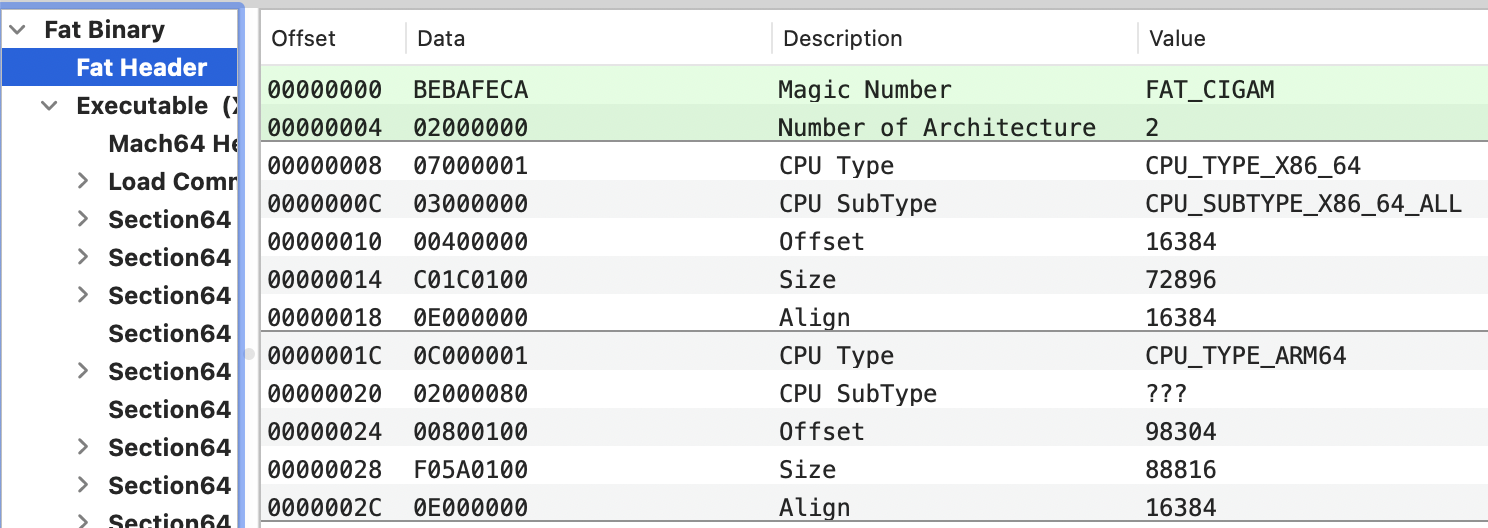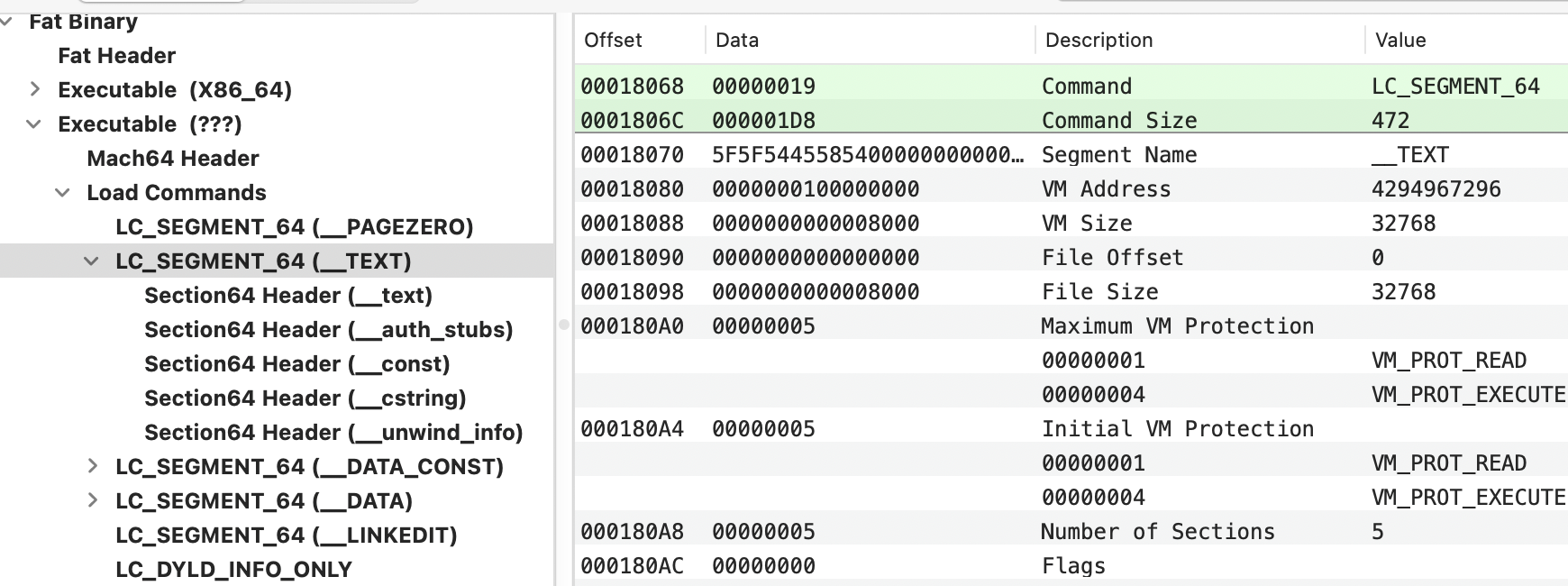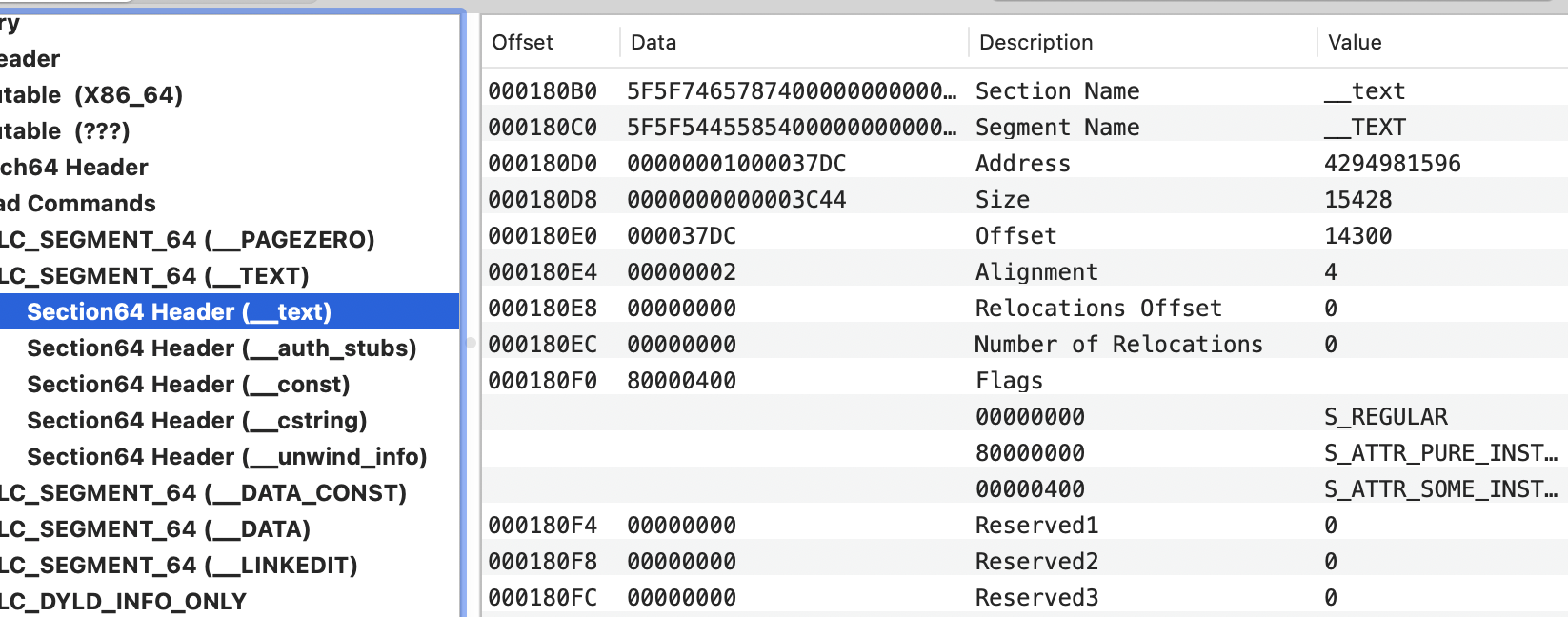29 KiB
macOS यूनिवर्सल बायनरी और Mach-O फॉर्मेट
{{#include ../../../banners/hacktricks-training.md}}
बुनियादी जानकारी
Mac OS के बायनरी आमतौर पर यूनिवर्सल बायनरी के रूप में कम्पाइल होते हैं। एक यूनिवर्सल बायनरी एक ही फ़ाइल में कई आर्किटेक्चर का समर्थन कर सकती है।
ये बायनरी Mach-O संरचना का पालन करते हैं, जो मूल रूप से निम्न हिस्सों से मिलकर बनती है:
- हेडर
- लोड कमांड्स
- डेटा
फैट हेडर
फाइल खोजने के लिए उपयोग करें: mdfind fat.h | grep -i mach-o | grep -E "fat.h$"
#define FAT_MAGIC 0xcafebabe
#define FAT_CIGAM 0xbebafeca /* NXSwapLong(FAT_MAGIC) */
struct fat_header {
uint32_t magic; /* FAT_MAGIC or FAT_MAGIC_64 */
uint32_t nfat_arch; /* number of structs that follow */
};
struct fat_arch {
cpu_type_t cputype; /* cpu specifier (int) */
cpu_subtype_t cpusubtype; /* machine specifier (int) */
uint32_t offset; /* file offset to this object file */
uint32_t size; /* size of this object file */
uint32_t align; /* alignment as a power of 2 */
};
हेडर में magic बाइट्स होती हैं, उसके बाद फ़ाइल में मौजूद archs की संख्या (nfat_arch) होती है और हर arch के लिए एक fat_arch struct होगा।
इसे जाँचें:
% file /bin/ls
/bin/ls: Mach-O universal binary with 2 architectures: [x86_64:Mach-O 64-bit executable x86_64] [arm64e:Mach-O 64-bit executable arm64e]
/bin/ls (for architecture x86_64): Mach-O 64-bit executable x86_64
/bin/ls (for architecture arm64e): Mach-O 64-bit executable arm64e
% otool -f -v /bin/ls
Fat headers
fat_magic FAT_MAGIC
nfat_arch 2
architecture x86_64
cputype CPU_TYPE_X86_64
cpusubtype CPU_SUBTYPE_X86_64_ALL
capabilities 0x0
offset 16384
size 72896
align 2^14 (16384)
architecture arm64e
cputype CPU_TYPE_ARM64
cpusubtype CPU_SUBTYPE_ARM64E
capabilities PTR_AUTH_VERSION USERSPACE 0
offset 98304
size 88816
align 2^14 (16384)
या Mach-O View टूल का उपयोग करके:

जैसा कि आप सोच रहे होंगे, सामान्यतः 2 आर्किटेक्चर के लिए कम्पाइल की गई एक यूनिवर्सल बाइनरी एक ही आर्किटेक्चर के लिए कम्पाइल की गई बाइनरी के आकार को दो गुना कर देती है।
Mach-O Header
हेडर फ़ाइल के बारे में बुनियादी जानकारी रखता है, जैसे कि उसे Mach-O फ़ाइल के रूप में पहचानने के लिए magic बाइट्स और लक्ष्य आर्किटेक्चर की जानकारी। आप इसे यहाँ पा सकते हैं: mdfind loader.h | grep -i mach-o | grep -E "loader.h$"
#define MH_MAGIC 0xfeedface /* the mach magic number */
#define MH_CIGAM 0xcefaedfe /* NXSwapInt(MH_MAGIC) */
struct mach_header {
uint32_t magic; /* mach magic number identifier */
cpu_type_t cputype; /* cpu specifier (e.g. I386) */
cpu_subtype_t cpusubtype; /* machine specifier */
uint32_t filetype; /* type of file (usage and alignment for the file) */
uint32_t ncmds; /* number of load commands */
uint32_t sizeofcmds; /* the size of all the load commands */
uint32_t flags; /* flags */
};
#define MH_MAGIC_64 0xfeedfacf /* the 64-bit mach magic number */
#define MH_CIGAM_64 0xcffaedfe /* NXSwapInt(MH_MAGIC_64) */
struct mach_header_64 {
uint32_t magic; /* mach magic number identifier */
int32_t cputype; /* cpu specifier */
int32_t cpusubtype; /* machine specifier */
uint32_t filetype; /* type of file */
uint32_t ncmds; /* number of load commands */
uint32_t sizeofcmds; /* the size of all the load commands */
uint32_t flags; /* flags */
uint32_t reserved; /* reserved */
};
Mach-O फ़ाइल प्रकार
There are different file types, you can find them defined in the source code for example here. The most important ones are:
MH_OBJECT: रिलोकेटेबल ऑब्जेक्ट फ़ाइल (कम्पाइलिंग के मध्यवर्ती उत्पाद, अभी निष्पादन योग्य नहीं)।MH_EXECUTE: निष्पादन योग्य फ़ाइलें।MH_FVMLIB: Fixed VM लाइब्रेरी फ़ाइल।MH_CORE: कोड डंप्सMH_PRELOAD: प्रीलोडेड निष्पादन योग्य फ़ाइल (अब XNU में समर्थित नहीं)MH_DYLIB: डायनेमिक लाइब्रेरीज़MH_DYLINKER: डायनेमिक लिंकरMH_BUNDLE: "प्लगइन फ़ाइलें". Generated using -bundle in gcc and explicitly loaded byNSBundleordlopen.MH_DYSM: Companion.dSymfile (file with symbols for debugging).MH_KEXT_BUNDLE: कर्नल एक्सटेंशंस।
# Checking the mac header of a binary
otool -arch arm64e -hv /bin/ls
Mach header
magic cputype cpusubtype caps filetype ncmds sizeofcmds flags
MH_MAGIC_64 ARM64 E USR00 EXECUTE 19 1728 NOUNDEFS DYLDLINK TWOLEVEL PIE
Or using Mach-O View:

Mach-O फ़्लैग्स
स्रोत कोड कुछ फ़्लैग्स भी परिभाषित करता है जो लाइब्रेरीज़ लोड करने में उपयोगी होते हैं:
MH_NOUNDEFS: कोई अपरिभाषित संदर्भ नहीं (पूर्ण रूप से लिंक्ड)MH_DYLDLINK: Dyld लिंकिंगMH_PREBOUND: डायनमिक संदर्भ प्रीबाउंड।MH_SPLIT_SEGS: फ़ाइल को r/o और r/w सेगमेंट में विभाजित करता है।MH_WEAK_DEFINES: बाइनरी में weak परिभाषित प्रतीक हैंMH_BINDS_TO_WEAK: बाइनरी weak symbols का उपयोग करती हैMH_ALLOW_STACK_EXECUTION: स्टैक को executable बनाता हैMH_NO_REEXPORTED_DYLIBS: लाइब्रेरी LC_REEXPORT कमांड्स के रूप में पुनः निर्यात नहीं होतीMH_PIE: Position Independent ExecutableMH_HAS_TLV_DESCRIPTORS: थ्रेड लोकल वेरिएबल्स वाला सेक्शन मौजूद हैMH_NO_HEAP_EXECUTION: heap/data पृष्ठों पर execution नहींMH_HAS_OBJC: बाइनरी में Objective-C सेक्शन हैंMH_SIM_SUPPORT: सिम्युलेटर सपोर्टMH_DYLIB_IN_CACHE: shared library cache में dylibs/frameworks पर उपयोग होता है।
Mach-O लोड कमांड्स
The file's layout in memory is specified here, detailing the symbol table's location, the context of the main thread at execution start, and the required shared libraries. Instructions are provided to the dynamic loader (dyld) on the binary's loading process into memory.
The uses the load_command structure, defined in the mentioned loader.h:
struct load_command {
uint32_t cmd; /* type of load command */
uint32_t cmdsize; /* total size of command in bytes */
};
There are about 50 different types of load commands that the system handles differently. The most common ones are: LC_SEGMENT_64, LC_LOAD_DYLINKER, LC_MAIN, LC_LOAD_DYLIB, and LC_CODE_SIGNATURE.
LC_SEGMENT/LC_SEGMENT_64
Tip
मूलतः, इस प्रकार का Load Command यह परिभाषित करता है कि बाइनरी के execute होने पर __TEXT (एक्जीक्यूटेबल कोड) और __DATA (प्रोसेस के लिए डेटा) segments को Data सेक्शन में दिए गए offsets के अनुसार कैसे लोड किया जाए।
ये कमांड्स उन segments को परिभाषित करते हैं जो किसी प्रोसेस के execute होने पर उसके वर्चुअल मेमोरी स्पेस में मैप किए जाते हैं।
कई तरह के segments होते हैं, जैसे कि __TEXT segment, जो किसी प्रोग्राम का executable code रखता है, और __DATA segment, जो प्रोसेस द्वारा उपयोग किए जाने वाले डेटा को रखता है। ये segments Mach-O फाइल के data section में स्थित होते हैं।
प्रत्येक segment को और भी छोटे-छोटे sections में बाँटा जा सकता है। लोड कमांड संरचना संबंधित segment के भीतर इन sections के बारे में जानकारी रखती है।
हैडर में सबसे पहले आपको segment header मिलता है:
struct segment_command_64 { /* for 64-bit architectures */
uint32_t cmd; /* LC_SEGMENT_64 */
uint32_t cmdsize; /* includes sizeof section_64 structs */
char segname[16]; /* segment name */
uint64_t vmaddr; /* memory address of this segment */
uint64_t vmsize; /* memory size of this segment */
uint64_t fileoff; /* file offset of this segment */
uint64_t filesize; /* amount to map from the file */
int32_t maxprot; /* maximum VM protection */
int32_t initprot; /* initial VM protection */
uint32_t nsects; /* number of sections in segment */
uint32_t flags; /* flags */
};
Example of segment header:

यह हेडर उन sections की संख्या जिनके हैडर इसके बाद दिखाई देते हैं को परिभाषित करता है:
struct section_64 { /* for 64-bit architectures */
char sectname[16]; /* name of this section */
char segname[16]; /* segment this section goes in */
uint64_t addr; /* memory address of this section */
uint64_t size; /* size in bytes of this section */
uint32_t offset; /* file offset of this section */
uint32_t align; /* section alignment (power of 2) */
uint32_t reloff; /* file offset of relocation entries */
uint32_t nreloc; /* number of relocation entries */
uint32_t flags; /* flags (section type and attributes)*/
uint32_t reserved1; /* reserved (for offset or index) */
uint32_t reserved2; /* reserved (for count or sizeof) */
uint32_t reserved3; /* reserved */
};
उदाहरण: सेक्शन हेडर:

यदि आप section offset (0x37DC) में उस offset को जोड़ें जहाँ arch शुरू होता है — इस मामले में 0x18000 — तो 0x37DC + 0x18000 = 0x1B7DC

आप command line के जरिए headers information भी प्राप्त कर सकते हैं:
otool -lv /bin/ls
Common segments loaded by this cmd:
__PAGEZERO: यह kernel को निर्देश देता है कि वह map करेaddress zeroको ताकि इसे read से, write से, या execute से रोक दिया जाए। संरचना में maxprot और minprot वेरिएबल्स को शून्य पर सेट किया जाता है ताकि सूचित हो कि इस पेज पर कोई read-write-execute अधिकार नहीं हैं।- यह allocation महत्वपूर्ण है ताकि NULL pointer dereference vulnerabilities को mitigate किया जा सके। इसका कारण यह है कि XNU एक hard page zero लागू करता है जो सुनिश्चित करता है कि memory का पहला पेज (सिर्फ पहला) inaccessible हो (i386 को छोड़कर)। एक बाइनरी इस आवश्यकता को पूरा कर सकता है छोटे __PAGEZERO का निर्माण करके (
-pagezero_sizeका उपयोग करके) जो पहले 4k को कवर करे और शेष 32bit memory को user और kernel मोड दोनों में accessible रखे। __TEXT: इसमें executable code होता है जिसमें read और execute permissions होते हैं (कोई writable नहीं). इस सेगमेंट के सामान्य सेक्शन्स:__text: Compiled binary code__const: Constant data (read only)__[c/u/os_log]string: C, Unicode or os logs string constants__stubsand__stubs_helper: डायनेमिक लाइब्रेरी लोडिंग प्रक्रिया के दौरान उपयोग होते हैं__unwind_info: स्टैक अनवाइंड डेटा।- ध्यान दें कि यह सभी कंटेंट signed होते हैं पर साथ ही executable के रूप में चिह्नित भी होते हैं (जिससे उन सेक्शन्स का exploitation करने के और विकल्प बनते हैं जिनको जरूरी नहीं कि यह privilege चाहिए, जैसे string dedicated sections)।
__DATA: इसमें डेटा होता है जो readable और writable होता है (कोई executable नहीं).__got:Global Offset Table__nl_symbol_ptr: Non lazy (bind at load) symbol pointer__la_symbol_ptr: Lazy (bind on use) symbol pointer__const: पढ़ने योग्य होना चाहिए (वास्तव में नहीं)__cfstring: CoreFoundation strings__data: Global variables (that have been initialized)__bss: Static variables (that have not been initialized)__objc_*(__objc_classlist, __objc_protolist, etc): Objective-C runtime द्वारा उपयोग की जाने वाली जानकारी__DATA_CONST: __DATA.__const की constant होने की गारंटी नहीं होती (write permissions), न ही अन्य pointers और GOT की। यह सेक्शन__const, कुछ initializers और GOT टेबल (एक बार resolved होने पर) कोmprotectका उपयोग करके read only बनाता है।__LINKEDIT: linker (dyld) के लिए जानकारी रखता है जैसे कि symbol, string, और relocation table entries। यह उन कंटेंट्स के लिए एक generic container है जो__TEXTया__DATAमें नहीं हैं और इसकी सामग्री अन्य load commands में वर्णित है।- dyld information: Rebase, Non-lazy/lazy/weak binding opcodes and export info
- Functions starts: Table of start addresses of functions
- Data In Code: Data islands in __text
- SYmbol Table: Symbols in binary
- Indirect Symbol Table: Pointer/stub symbols
- String Table
- Code Signature
__OBJC: Objective-C runtime द्वारा उपयोग की जाने वाली जानकारी रखता है। हालांकि यह जानकारी __DATA सेगमेंट में भी मिल सकती है, विभिन्न __objc_* सेक्शन्स के भीतर।__RESTRICT: एक ऐसा सेगमेंट जिसका कोई कंटेंट नहीं होता और जिसमें एक अकेला सेक्शन होता है जिसका नाम__restrict(यह भी खाली) है, जो सुनिश्चित करता है कि बाइनरी चलने पर यह DYLD environmental variables को ignore करे।
जैसा कि कोड में देखा जा सकता है, segments flags को भी सपोर्ट करते हैं (हालाँकि इनका बहुत अधिक उपयोग नहीं होता):
SG_HIGHVM: Core only (not used)SG_FVMLIB: Not usedSG_NORELOC: Segment has no relocationSG_PROTECTED_VERSION_1: एन्क्रिप्शन। उदाहरण के लिए Finder द्वारा text__TEXTsegment को एन्क्रिप्ट करने के लिए प्रयोग किया जाता है।
LC_UNIXTHREAD/LC_MAIN
LC_MAIN entryoff attribute में entrypoint रखता है। लोड समय पर, dyld बस इस मान को (in-memory) base of the binary में जोड़ देता है, फिर इस निर्देश पर jump करके बाइनरी के कोड के निष्पादन को शुरू करता है।
LC_UNIXTHREAD में वे मान होते हैं जो main thread शुरू करते समय registers में होने चाहिए। यह पहले से ही deprecated है लेकिन dyld अभी भी इसका उपयोग करता है। आप इसके द्वारा सेट किए गए registers के values को यह कमांड देखकर देख सकते हैं:
otool -l /usr/lib/dyld
[...]
Load command 13
cmd LC_UNIXTHREAD
cmdsize 288
flavor ARM_THREAD_STATE64
count ARM_THREAD_STATE64_COUNT
x0 0x0000000000000000 x1 0x0000000000000000 x2 0x0000000000000000
x3 0x0000000000000000 x4 0x0000000000000000 x5 0x0000000000000000
x6 0x0000000000000000 x7 0x0000000000000000 x8 0x0000000000000000
x9 0x0000000000000000 x10 0x0000000000000000 x11 0x0000000000000000
x12 0x0000000000000000 x13 0x0000000000000000 x14 0x0000000000000000
x15 0x0000000000000000 x16 0x0000000000000000 x17 0x0000000000000000
x18 0x0000000000000000 x19 0x0000000000000000 x20 0x0000000000000000
x21 0x0000000000000000 x22 0x0000000000000000 x23 0x0000000000000000
x24 0x0000000000000000 x25 0x0000000000000000 x26 0x0000000000000000
x27 0x0000000000000000 x28 0x0000000000000000 fp 0x0000000000000000
lr 0x0000000000000000 sp 0x0000000000000000 pc 0x0000000000004b70
cpsr 0x00000000
[...]
LC_CODE_SIGNATURE
{{#ref}} ../../../generic-methodologies-and-resources/basic-forensic-methodology/specific-software-file-type-tricks/mach-o-entitlements-and-ipsw-indexing.md {{#endref}}
Contains information about the code signature of the Mach-O file. It only contains an offset that points to the signature blob. This is typically at the very end of the file.
However, you can find some information about this section in this blog post and this gists.
LC_ENCRYPTION_INFO[_64]
बाइनरी एन्क्रिप्शन के लिए समर्थन। हालांकि, ज़ाहिर है, अगर कोई attacker प्रक्रिया को compromise कर लेता है, तो वह मेमोरी को अनएन्क्रिप्टेड dump कर पाएगा।
LC_LOAD_DYLINKER
यह उस dynamic linker executable के path को बताता है जो shared libraries को process address space में map करता है। value हमेशा /usr/lib/dyld पर सेट रहती है। यह ध्यान देने योग्य है कि macOS में, dylib mapping user mode में होता है, kernel mode में नहीं।
LC_IDENT
अब प्रचलन में नहीं है, लेकिन जब panic पर dumps generate करने के लिए कॉन्फ़िगर किया जाता है, तो एक Mach-O core dump बनाया जाता है और kernel version LC_IDENT कमांड में सेट किया जाता है।
LC_UUID
Random UUID। यह प्रत्यक्ष रूप से किसी भी चीज़ के लिए उपयोगी हो सकता है लेकिन XNU इसे बाकी process info के साथ cache करता है। इसे crash reports में इस्तेमाल किया जा सकता है।
LC_DYLD_ENVIRONMENT
यह dyld को environment variables बताने की अनुमति देता है इससे पहले कि process execute हो। यह बहुत खतरनाक हो सकता है क्योंकि इससे process के अंदर arbitrary code execute होने की अनुमति मिल सकती है, इसलिए यह load command केवल dyld build में #define SUPPORT_LC_DYLD_ENVIRONMENT के साथ उपयोग किया जाता है और प्रोसेसिंग को केवल DYLD_..._PATH स्वरूप के variables तक सीमित करता है जो load paths निर्दिष्ट करते हैं।
LC_LOAD_DYLIB
This load command describes a dynamic library dependency which instructs the loader (dyld) to load and link said library. There is a LC_LOAD_DYLIB load command for each library that the Mach-O binary requires.
- यह load command प्रकार
dylib_commandकी एक संरचना है (जिसमें एक struct dylib होता है, जो वास्तविक dependent dynamic library का वर्णन करता है):
struct dylib_command {
uint32_t cmd; /* LC_LOAD_{,WEAK_}DYLIB */
uint32_t cmdsize; /* includes pathname string */
struct dylib dylib; /* the library identification */
};
struct dylib {
union lc_str name; /* library's path name */
uint32_t timestamp; /* library's build time stamp */
uint32_t current_version; /* library's current version number */
uint32_t compatibility_version; /* library's compatibility vers number*/
};
आप यह जानकारी cli से भी प्राप्त कर सकते हैं:
otool -L /bin/ls
/bin/ls:
/usr/lib/libutil.dylib (compatibility version 1.0.0, current version 1.0.0)
/usr/lib/libncurses.5.4.dylib (compatibility version 5.4.0, current version 5.4.0)
/usr/lib/libSystem.B.dylib (compatibility version 1.0.0, current version 1319.0.0)
कुछ संभावित malware संबंधित लाइब्रेरीज़ हैं:
- DiskArbitration: USB ड्राइव्स की निगरानी
- AVFoundation: ऑडियो और वीडियो कैप्चर करना
- CoreWLAN: Wi-Fi स्कैन।
Tip
एक Mach-O बाइनरी में एक या अधिक constructors हो सकते हैं, जिन्हें LC_MAIN में निर्दिष्ट पते से पहले निष्पादित किया जाता है।
किसी भी constructors के offsets __mod_init_func सेक्शन में रखे जाते हैं जो __DATA_CONST सेगमेंट का हिस्सा है।
Mach-O डेटा
फाइल के मूल में डेटा क्षेत्र होता है, जो load-commands क्षेत्र में परिभाषित कई सेगमेंट्स से बना होता है। प्रत्येक सेगमेंट के भीतर विभिन्न डेटा सेक्शन्स हो सकते हैं, और प्रत्येक सेक्शन किसी विशिष्ट प्रकार के लिए code या data रखता है।
Tip
डेटा मूलतः वह भाग है जिसमें load commands LC_SEGMENTS_64 द्वारा लोड की जाने वाली सभी जानकारी होती है।
यह शामिल करता है:
- Function table: जो प्रोग्राम के functions के बारे में जानकारी रखता है।
- Symbol table: जो बाइनरी द्वारा उपयोग की जाने वाली external functions के बारे में जानकारी रखता है।
- यह अंदरूनी function, variable नामों और अन्य चीज़ों को भी शामिल कर सकता है।
To check it you could use the Mach-O View tool:

Or from the cli:
size -m /bin/ls
Objetive-C सामान्य अनुभाग
__TEXT सेगमेंट (r-x) में:
__objc_classname: क्लास नाम (strings)__objc_methname: मेथड नाम (strings)__objc_methtype: मेथड प्रकार (strings)
__DATA सेगमेंट (rw-) में:
__objc_classlist: सभी Objetive-C क्लासेस के पॉइंटर्स__objc_nlclslist: Non-Lazy Objetive-C क्लासेस के पॉइंटर्स__objc_catlist: Categories का पॉइंटर__objc_nlcatlist: Non-Lazy Categories का पॉइंटर__objc_protolist: प्रोटोकॉल्स सूची__objc_const: स्थिर डेटा__objc_imageinfo,__objc_selrefs,objc__protorefs...
Swift
_swift_typeref,_swift3_capture,_swift3_assocty,_swift3_types, _swift3_proto,_swift3_fieldmd,_swift3_builtin,_swift3_reflstr
{{#include ../../../banners/hacktricks-training.md}}


